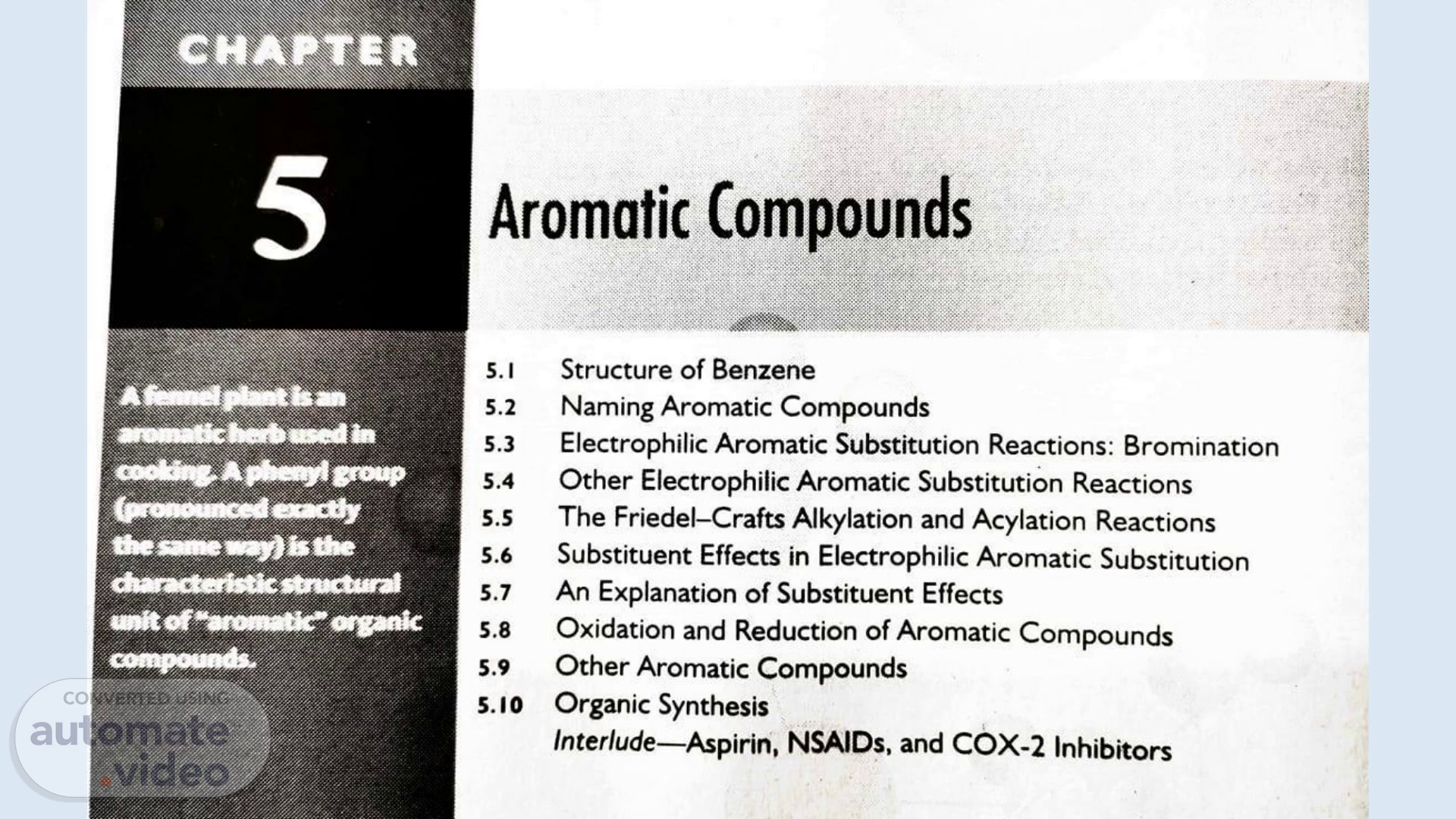Scene 1 (0s)
Aromatic Compounds 5.1 5.2 5.3 5.4 5.5 5.6 5.7 5.8 5.9 5.10 Structure of Benzene Naming Aromatic Compounds Electrophilic Aromatic Substitution Reactions: Bromination Other Electrophilic Aromatic Substitution Reactions The Friedel—Crafts Alkylation and Acylation Reactions Substituent Effects in Electrophilic Aromatic Substitution An Explanation of Substituent Effects Oxidation and Reduction of Aromatic Compounds Other Aromatic Compounds Organic Synthesis Interlude—Aspirin, NSAIDs, and COX-2 Inhibitors.
Scene 2 (18s)
Benzene CH3 0 HO Estrone Atorvastatin (Lipitor).
Scene 3 (23s)
HBr catalyst Benzene Bromobenzene (substitution product) (Addition product) NOT formed.
Scene 4 (29s)
(a) (b).
Scene 5 (35s)
4 and 1,2-Dibromobenzene.
Scene 6 (41s)
TABLE 5. I Common Names of Some Aromatic Compounds Structure CH3 OH NH2 o CH3 Name Structure Toluene (bp 111 0 C) Phenol (mp 43 a c) Aniline (bp 184 0 C) Acetophenone (mp 21 oc) CHO C02H CH3 CH3 c Name Benzaldehyde (bp 178 Benzoic acid (mp 122 0 C) ortho-Xylene Styrene (bp 145 oc).
Scene 7 (52s)
Monosubstituted benzenes are systetnatically named in the same manner as other hydro- carbons. with -benzene as the parent natne. Thus, C6H5Br is bromobenzene, C6H5N02 is nitrobenzene, and C6H5CH2CH3 is ethylbenzene. The name phenyl, pronounced fen-nil and sometimes abbreviated as Ph or (Greek phi), is used for the —C6H5 unit when the benzene ring is considered as a substituent. In addition, a generalized aromatic substituent is called an aryl group, abbreviated as Ar, and the name benzyl is used for the C6H5CH2— group. Bromobenzene N02 Nitrobenzene CH2CH3 Ethylbenzene A phenyl group A benzyl group.
Scene 8 (1m 16s)
Disubstituted benzenes are named using one of the prefixes ortho- (o), meta- (m), or para- (p). An ortho-disubstituted benzene has its two substituents in a 1,2 relationship on the ring; • a meta-disubstituted benzene has its two substituents in a 1,3 relationship; and a para- disubstituted benzene has its substituents in a 1,4 relationship. o 2 Cl ortho.DichIorobenzene 1,2 disubstituted 2 Hac 3 meta-DimethyIbenzene (meta-xylene) 1,3 disubstituted 2 4 Cl para-Chlorobenzaldehyde 1,4 disubstituted.
Scene 9 (1m 37s)
As with cycloalkanes (Section 2.7), benzenes with more than two substituents are named by choosing a point of at tachtnent as carbon 1 and numbering the substituents on the ring so that the second substituent has as low a number as possible. The substituents are listed alphabeti_ cally when writing the name. Sr CH3 4-Bromo-1 ,2-dimethylbenzene OH CH3 H3C •5 2,5-Dimethylphenol CH3 02N N02 N02 2,4,6-TrinitrotoIuene (TNT).
Scene 10 (1m 56s)
WORKED EXAMPLE S. I Naming an Aromatic Compound M71at is the IUPAC name of the following compound? N02 Solution Because the nitro group (—N02) and chloro group are on carbons 1 and 3, they have a meta relationship. Citing the two substituents in alphabetical order gives the IUPAC name m-chloronitrobenzene..
Scene 11 (2m 10s)
[Virtual Presenter] ACTIVITY1. ACTIVITY 1.
Scene 12 (2m 16s)
Problem 5.2 Tell whether the following compounds are ortho, meta, or para disubstituted: CH3 (c) N02 Problem 5.3 Give IUPAC names for the following compounds: (a) Cl CH3 (e) 02N CH3 CH2CH2CHCH3 CH2CH3 N02 (c) H3C S03H OH NH2 CH3 CH3 CH3.
Scene 13 (2m 28s)
Problem 5.4 Draw structures corresponding to the following IUPAC names: (a) p-Bromochlorobenzene (c) m-Chloroaniline (b) p-Bromotoluene (d) I-Chloro-3,5-dimethylbenzene.
